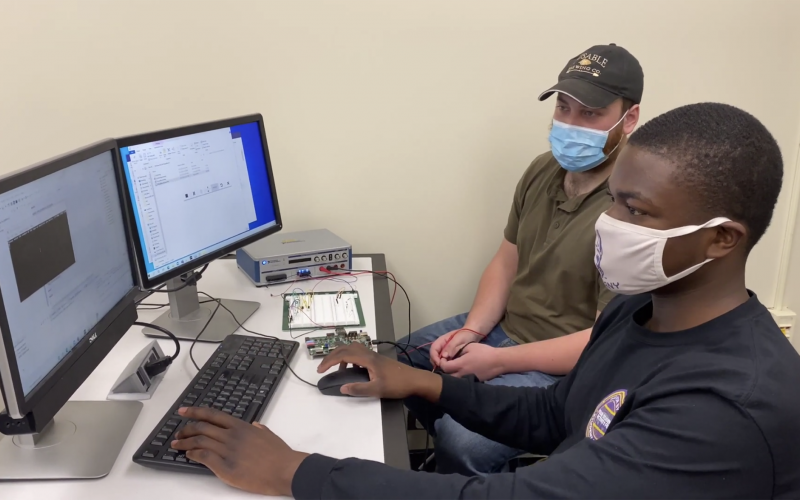Engineering Students Present Senior Capstone Projects

ALBANY, N.Y. (May 25, 2021) — How do you design a testing environment capable of reproducing the searing heat of 300 degrees Celsius? That was the task presented to one of the student research teams taking part in UAlbany’s College of Engineering and Applied Sciences Senior Capstone project during the past year.
With most in-person collaboration limited due to COVID-19 restrictions, the team of Merciful Ajayi, Jon Fronckowiak, Allanah Matthews and Sean McNessor set up a virtual environment that could simulate the conditions in which Naval nuclear reactor elements need to be capable of functioning. Working with engineers at Knolls Atomic Power Laboratory, the students presented their findings on a “Multipurpose FPGA Detector Emulator,” as part of the senior capstone presentations this month for CEAS.
It was one of six student groups taking part in the year-long design experience, which offers opportunities for teams of students to propose, design, build, test, demonstrate, present and fully document a working prototype of a sophisticated electronic system.
In the fall semester, student teams interact with industry sponsors or faculty to develop a proposal for a system, component or process to meet desired needs and specifications within constraints.
“Students are tasked with identifying opportunities, develop requirements, perform analysis and synthesis, generate multiple solutions, evaluate solutions against requirements, consider risks and make trade-offs,” said Electrical and Computer Engineering Professor of Practice Jonathan Muckell, who oversees the course and helps arrange for the students to engage with industry partners.
The second semester is then dedicated to buildout of the system, as student teams continue to interact with their partners as they implement their design and conduct validation experiments to demonstrate that their design meets all engineering specifications, standards and constraints.
In addition to the Naval Nuclear Lab team, other student projects included the design of novel solar power devices, wearable motion tracking systems and further development of “UAlbany1,” a nanosatellite or CubeSat that could be launched as part of a constellation of to measure everything from moisture of soil on Earth to surface temperatures on the moon.
In documenting their work, student teams must also evaluate their designs in global, cultural, social, environmental and economic context and develop recommendations for future development.
“The capstone design experience in CEAS provides a dose of the real-world as it pushes our students to bring together what they’ve learned and to work together effectively in teams,” said CEAS Dean Kim L. Boyer. “The projects undertaken by this year’s graduates shows impressive variety — each demonstrating Science in Service to Society.”
The 2020-21 Electrical and Computer Engineering Capstone Experience teams include:
- Concentrated Solar Power for use with Peltier Devices to Generate Electricity (working with ECE Professor of Practice Jeffrey Braunstein): Muhammad Hasher-Nasir, Joshua Lindsay, Royce Lobban, Alexander Maggiacomo
- Universal Input Direct-AC powered Luminaire (working with G&G Industrial Lighting): Michelle Jimenez, Najib Lalani, Eric Liang
- UAlbany1 CubeSat: Radiometer Payload for Detecting Thermal Noise at 1GHz (working with ECE Assistant Professor Mustafa Aksoy): Salim Al-Amry, Vince Bruno, Benjamin Poholchuk
- Wearable Motion Tracking System to Reduce Back Injury (working with ECE Professor of Practice Jonathan Muckell): Stephane Keene, Brendan Lawrence, Rasheed Orleans, Andi Volaj
- UAlbany App for Students (working with ECE Assitant Professor Daphney-Stavroula Zois, Computer Science Assistant Professor Charalampos Chelmis and Associate Professor of Social Welfare Wonhyung Lee): Sergio Gurierrez, Mohamed Hashem, Krithika Sundaram
- Multipurpose FPGA Detector Emulator (working with researchers at the Naval Nuclear Laboratory): Merciful Ajayi, Jon Fronckowiak, Allanah Matthews, Sean McNessor




